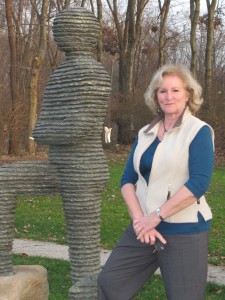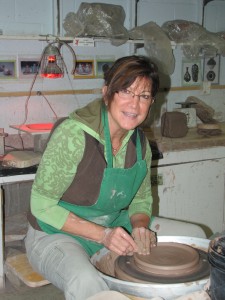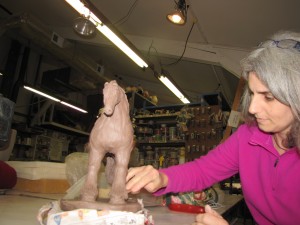The art of survival

It”™s been more than 60 years since a dedicated group of artists including actress and singer Lotte Lenya and her husband, composer Kurt Weill, along with Helen Hayes, Aaron Copland, Paulette Goddard and Maxwell Anderson founded Rockland Center for the Arts in a village of Nyack storefront.
Today, RoCA has expanded to a 10- acre site in West Nyack, where it offers every medium an artist can dream of ”“ no easy task to accomplish in these days of a lingering recession.
Even on a relatively quiet Monday afternoon, the building is alive with sculptors, painters and potters. Julianne Ramos, who has been RoCA”™s executive director for 25 years, said the economy has been a challenge the nonprofit has met creatively.
No space in the 1,500-square-foot building lies unused ”“ the main entrance hosts an ongoing solo show and leads into its main exhibit room, which has a revolving theme and serves as a theatrical and music center venue as well. It is surrounded by rooms where dancing, drawing, music and sculpting are ongoing. It also has two media rooms in which digital artwork is displayed.

RoCA”™s property was donated by Maryann Emerson. As Emerson downsizes her living quarters nearby, many of the works she collected through the years are being donated to RoCA and sold to art lovers.
“She”™s been amazingly kind to us,” said Ramos, showing a delicately sculpted angel among the many current donations. “With the support of our patrons and an enthusiastic board of directors, we”™ve been able to weather the storm.”

Ramos said the gallery began to feel the effects of the financial meltdown almost immediately. “We run a great summer program here, and we usually have a waiting list of more than 100 children … but by the end of 2008, there was no waiting list; that was the first indication we had the economy was souring. People are very cautious about discretionary spending and have become more so.”
Funding, too, has become a competitive game ”“ corporate giving has decreased and funding from the New York State Council for the Arts dropped 12 percent in 2010 and another 10 percent in 2011, Ramos said. Rockland County has also reduced its funding to the arts.
“Today, we have three levels of funding,” she said. “Those who continue to give all, those who give half of what they once did ”“ or those who now give zero.”

RoCA”™s saving grace has been that 70 percent of its income is derived from classes, admission to performances and its day camp, “which is geared for the middle-class pocketbook,” she said. “Unfortunately, our middle class is dwindling ”“ we have a scholarship fund established for the camp, which does help those in need ”“ and people continue to support our classes … but we”™ve seen many nonprofits struggling to continue to provide services while dealing with less funding. It has made every one of us more creative ”“ for some, it is truly a juggling act.”
Rockland”™s economic base is predominantly small-business oriented, Ramos said. “There are very few large corporations here, so it is more difficult for smaller businesses to donate than it was pre-recession. We do have a donor base ”“ and we do keep an eye on our organization”™s mission and do maintain the quality of our programs ”“ although we”™ve streamlined our operations as much as humanly possible.”
Grant writing must be specific, Ramos said. “There are many grants out there, but to be successful in being selected, you must zero in on that which you will be most likely to succeed in getting.”
Art education is a very important aspect of what RoCA is all about. “We administer the county”™s Art in Public program. We are the only county outside New York City to have one. It”™s called One Percent for Art ”“ all county-bonded projects set aside 1 percent of its dollar amount to place a work of art at the site. We have a group of art specialists appointed by the county executive and our legislature.” Since 1984, 38 permanent displays dot the county.
With funding down $100,000 in 2010, ROCA is also down one full-time and two part-time positions through attrition. “When times are difficult, we tighten our belts like everyone else. We have less staff, but keep the quality of the programs and the number of programs intact. More importantly, we always look to remain accessible. If the recession has done anything positive, it”™s deepened our passion to persevere to spite adversity.”